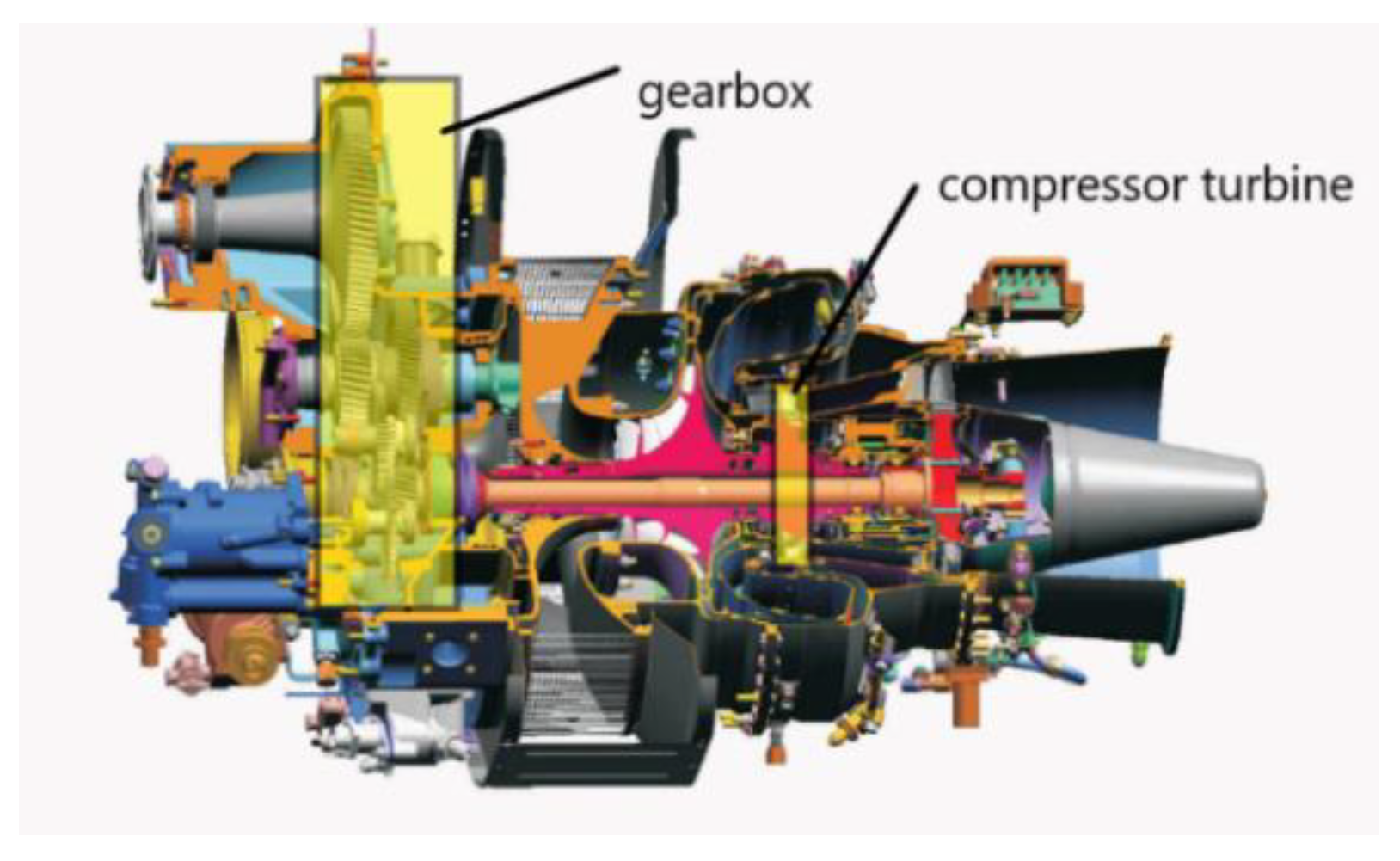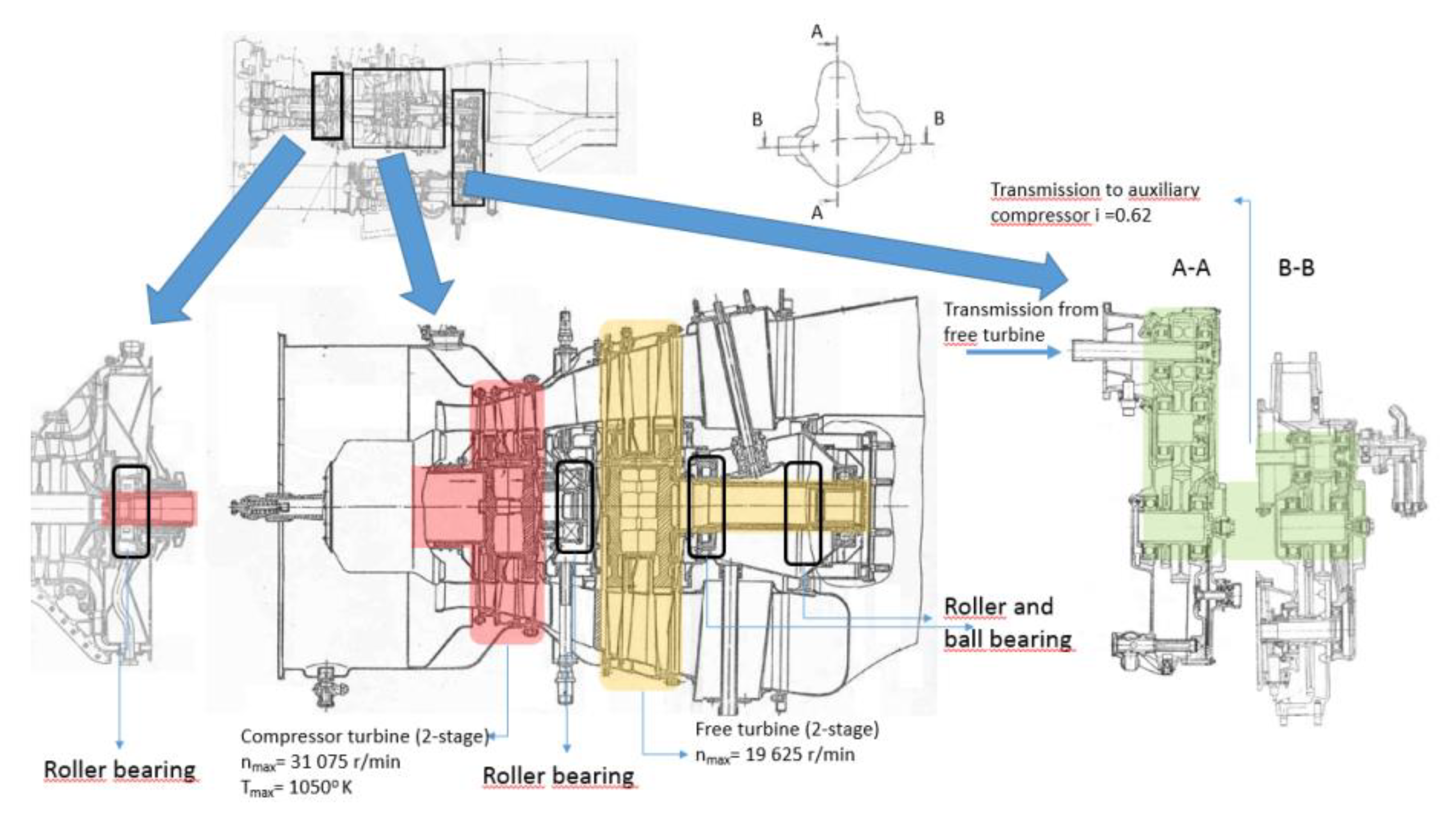Review of Small Gas Turbine Engines and Their Adaptation for Automotive Waste Heat Recovery Systems
Abstract
:1. Introduction
2. Review of Potential TC Solutions
2.1. Review of Small Turbojet Engines
2.2. Review of Small Turboshaft Engines
3. Results and Discussion
4. Adaptation for OP Engine
5. Conclusions
- The literature review showed that parallel TC offered smaller BSFC reduction compared to series TC. This is attributed to the fact that in a parallel configuration, a greater amount of exhaust gases flow through a compressor turbine rather than a power turbine.
- Parallel TC produced smaller back-pressure compared to series TC, as the power turbine is not placed directly behind turbocharger. This position of the power turbine does not limit the pressure ratio of the turbocharger.
- In total, 25 turbine engines were compared, considering their maximal TIT, RPM, and ṁair.
- The Noel Penni NPT754, NPT301, Teledyne J402, 312, Microturbo TRI60-1, Williams YJ400, and F107 turbojet engines were considered appropriate for the TC unit. However, such engines are not equipped with a power output shaft, which has to be manufactured.
- The TA12-60, TA-6A, AI-8, AI-9, AI-450, APS2300, APS3200, and GTD-350 turboshaft engines were considered. These engines meet the requirements regarding the TIT, RPM, and ṁair. Additionally, these engines are equipped with a power output shaft and a gearbox. The output shaft and the gearbox can be used to transmit torque onto the crankshaft.
- The adaptation of the turbine engine into an ICE engine was presented, including the turbine wheels of the GTD-350 engine and the K44 radial inflow turbine.
6. Plans for Further Research
Author Contributions
Funding
Acknowledgments
Conflicts of Interest
Nomenclature
| Symbols | |
| Tin | Turbine inlet temperature [] |
| Air mass flow rate [kg/s] | |
| Maximal turbine revolutions per minute [ | |
| Maximal engine power [] | |
| Abbreviations | |
| TC | Turbocompounding |
| ICE | Internal Combustion Engine |
| mech-TC | Mechanical Turbocompounding |
| el-TC | Electric Turbocompounding |
| HDD | Heavy-Duty Diesel |
| EGR | Exhaust Gas Recirculation |
| RCC | Rankine Combined Cycle |
| BSFC | Brake Specific Fuel Consumption |
| VTG | Variable Turbine Geometry |
| BMEP | Brake Mean Effective Pressure |
| ORC | Organic Rankine Cycle |
| TIT | Turbine Inlet Temperature |
| RPM | Revolutions Per Minute |
| HP | High-Pressure Turbine |
| LP | Low Single-Pressure Turbine |
| AC | Alternating Current |
| DC | Direct Current |
References
- Jääskeläinen, H.; Majewski, W. Waste heat recovery for heavy-duty diesel engines: A review of mechanical turbocompounding. In Proceedings of the ASME Internal Combustion Engine Division Fall Technical Conference, Seattle, WA, USA, 15–18 October 2017. [Google Scholar]
- Pawlak, G. The history of the Scania engines. Combust. Engines 2010, 1, 40–49. [Google Scholar]
- Yamaguchi, T.; Aoyagi, Y.; Uchida, N.; Fukunaga, A. Fundamental study of waste heat recovery in the high boosted 6-cylinder heavy duty diesel engine. SAE Int. J. Mater. Manuf. 2015, 8, 209–226. [Google Scholar] [CrossRef]
- Ismail, Y.; Durrieu, D.; Menegazzi, P.; Chesse, P. Potential of exhaust heat recovery by turbocompounding. SAE Tech. Paper 2012, 1–15. [Google Scholar] [CrossRef]
- Ismail, Y.; Durrieu, D.; Menegazzi, P.; Chesse, P. Study of parallel turbocompounding for small displacement engines. SAE Tech. Paper 2013, 1–14. [Google Scholar] [CrossRef]
- Di Battista, D.; Gualtieri, A.; Cipollone, R. Turbocompound systems to recover energy in ICE. Int. J. Eng. Innov. Technol. 2014, 3, 249–257. [Google Scholar]
- Bin, M.A.; Romagnoli, A.; Ricardo, M.B. Design and development of a low pressure turbine for turbocompounding applications. Int. J. Gas Turbine Propuls. Power Syst. 2012, 4, 1–8. [Google Scholar]
- Wasselin, T.; Richard, S.; Le Berr, F.; Dabadie, J. Potential of several alternative propulsion systems for light rotorcrafts applications. SAE Int. J. Aerosp. 2013, 6, 563–570. [Google Scholar] [CrossRef]
- He, G.; Xie, H. Fuel saving potential of different turbo-compounding systems under steady and driving cycles. SAE Tech. Paper 2015, 1–11. [Google Scholar] [CrossRef]
- Mamat, A.B.; Martinez-Botas, R.F.; Chiong, M.C.; Rajoo, S.; Petrovic, S.; Romagnoli, A. Exhaust gas energy recovery via electric turbocompounding. In Proceedings of the International Conference of Applied Energy, Abu Dhabi, UAE, 28–31 March 2015. [Google Scholar] [CrossRef] [Green Version]
- Salehi, R.; Stefanopoulou, A.; Kiwan, R.; Martz, J. Design considerations for waste energy recovery with electric turbocompounding. In Proceedings of the ASME 2016 Dynamic Systems and Control Conference (DSCC2016), Minneapolis, MN, USA, 12–14 October 2016. [Google Scholar]
- Brooks, V. Small turbine engine evolution. SAE Int. J. Aerosp. 2009, 1, 915–928. [Google Scholar] [CrossRef]
- William, E.K. Turbine powerplants for missiles—Cost improvement requirements. SAE Trans. 1973, 82, 1250–1257. [Google Scholar]
- Bakaljev, W.L.; Gavrilov, V.V.; Dobrjakov, J.I. Inostrannye Aviatsionnye Dvigateli; Editorial office “Avimir”: Moskva, Russian, 2000; pp. 1–534. ISBN 5-94049-002-6. [Google Scholar]
- Radikovic, I.G.; Jevgjenievic, A.K. Analiz i prognoz razvitiyaotech estvennykhv spomogatel’ny khsilovykhustanovok na 2020 god. Molodoj Ucjenyj 2018, 48, 19–24. [Google Scholar]
- Ivchenko AI-450 Brochure. Available online: http://ivchenko-progress.com/wp-content/uploads/pdf/ai450-v2opt.pdf (accessed on 20 July 2019).
- Ministerstvo Grazhdanskoy Aviatsii. Aviatsionnyy Turboreaktivnyy Dvigatel’ RU-19A-300 Rukovodstv Opoekspluatatsiiite Khnicheskom Uobsluzhivaniyu; Corp. “TEHNOLOG”; Ministerstvo Grazhdanskoy Aviatsii: Rostov-on-Don, Russia, 2001; pp. 1–188. [Google Scholar]
- Ministerstvo Grazhdanskoy Aviatsii. Dvigatel’ TA-6A Rukovodstvo po Tekhnicheskoy Ekspluatatsii; Ministerstvo Grazhdanskoy Aviatsii: Rostov-on-Don, Russia, 1987; pp. 1–396. [Google Scholar]
- Ministerstvo Grazhdanskoy Aviatsii. Dvigatel’ TA-8V Rukovodstvo po Tekhnicheskoy Ekspluatatsii; Ministerstvo Grazhdanskoy Aviatsii: Rostov-on-Don, Russia, 1986; pp. 1–285. ISBN 978-5-458-34914-7. [Google Scholar]
- Dowództwo Wojsk Lotniczych. Silnik AI-9W Eksploatacja i Obsługa Techniczna; Dowództwo Wojsk Lotniczych: Poznań, Polska, 1981; pp. 1–83.
- Ministerstvo Grazhdanskoy Aviatsii. Vspomogatel’nyy Gazoturbinnyy Dvigatel’ VSU-10 Rukovodstvo po Tekhnicheskoy Ekspluatatsii; Ministerstvo Grazhdanskoy Aviatsii: Rostov-on-Don, Russia, 1983; pp. 1–569. [Google Scholar]
- Ministerstvo Grazhdanskoy Aviatsii. Dvigatel’ GTDE-117 Rukovodstvo po Tekhnicheskoy Ekspluatatsii; Ministerstvo Grazhdanskoy Aviatsii: Rostov-on-Don, Russia, 1990; pp. 1–421. [Google Scholar]
- Woodhouse, G. Auxiliary power unit evolution—Meeting tomorrow’s challenges. SAE Tech. Paper 1993, 1–8. [Google Scholar] [CrossRef]
- Cross-Section Image of APS5000 APU. Available online: http://alliance.sdccmesa.com/wp-content/uploads/2012/04/sundstrandAPS5000hires.jpg (accessed on 20 July 2019).
- Dowództwo Wojsk Lotniczych. Opis Techniczny Silnika GTD-350 III Serii; Dowództwo Wojsk Lotniczych: Poznań, Polska, 1985; pp. 1–450.

















© 2020 by the authors. Licensee MDPI, Basel, Switzerland. This article is an open access article distributed under the terms and conditions of the Creative Commons Attribution (CC BY) license (http://creativecommons.org/licenses/by/4.0/).
Share and Cite
Kozak, D.; Mazuro, P. Review of Small Gas Turbine Engines and Their Adaptation for Automotive Waste Heat Recovery Systems. Int. J. Turbomach. Propuls. Power 2020, 5, 8. https://doi.org/10.3390/ijtpp5020008
Kozak D, Mazuro P. Review of Small Gas Turbine Engines and Their Adaptation for Automotive Waste Heat Recovery Systems. International Journal of Turbomachinery, Propulsion and Power. 2020; 5(2):8. https://doi.org/10.3390/ijtpp5020008
Chicago/Turabian StyleKozak, Dariusz, and Paweł Mazuro. 2020. "Review of Small Gas Turbine Engines and Their Adaptation for Automotive Waste Heat Recovery Systems" International Journal of Turbomachinery, Propulsion and Power 5, no. 2: 8. https://doi.org/10.3390/ijtpp5020008
APA StyleKozak, D., & Mazuro, P. (2020). Review of Small Gas Turbine Engines and Their Adaptation for Automotive Waste Heat Recovery Systems. International Journal of Turbomachinery, Propulsion and Power, 5(2), 8. https://doi.org/10.3390/ijtpp5020008




